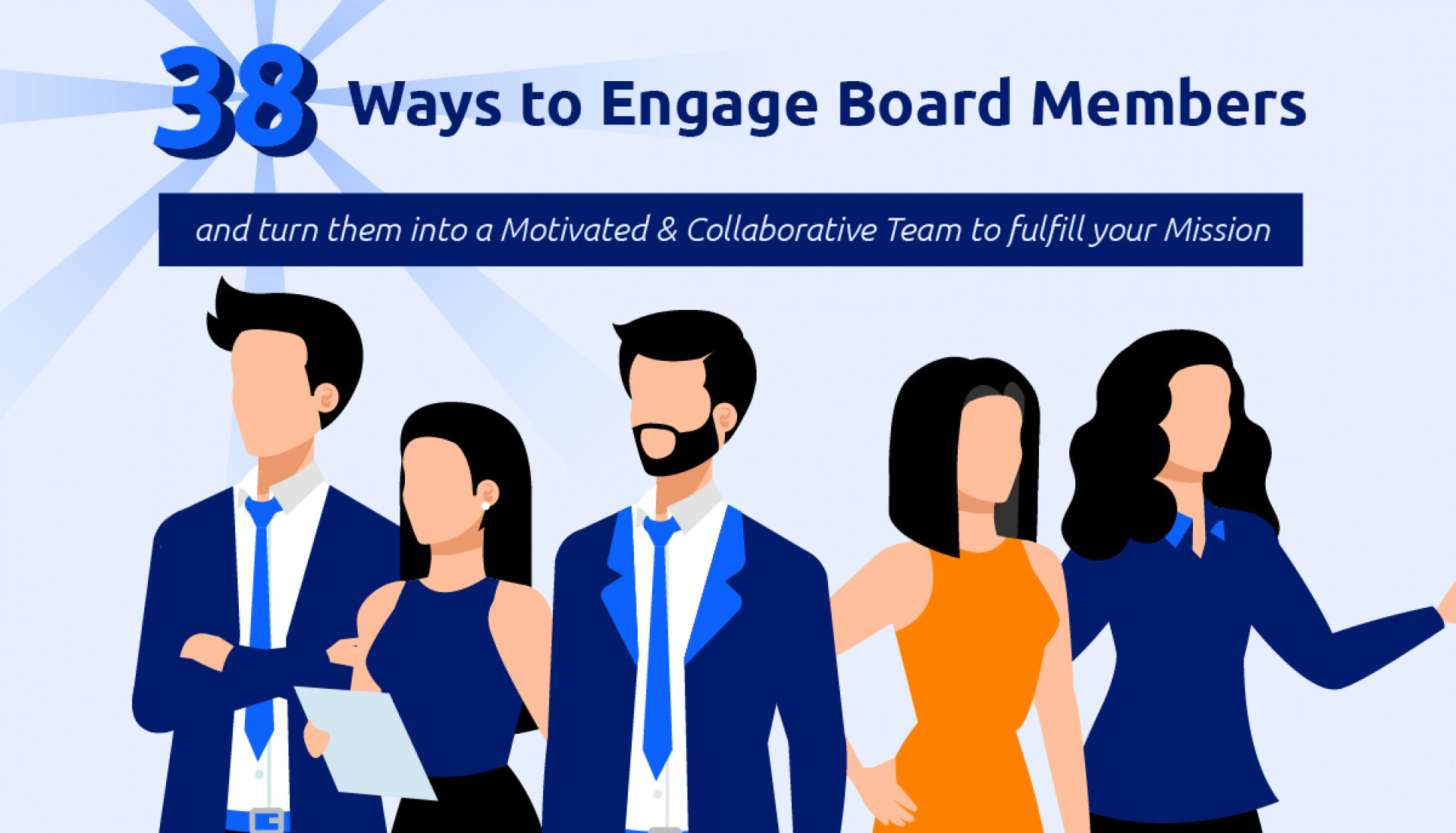
When board members are engaged, they feel more connected to the organization and care more about their responsibilities. Engaged board members can promote teamwork, leading to personal growth, productivity, and innovation.
If you are looking for ways to engage board members, you've come to the right place. This article will give you some of the best strategies that can help create a meaningful experience to keep them satisfied and involved.
Key Takeaways
- Engaged board members contribute more effectively, boosting teamwork, productivity, and innovation.
- A structured onboarding process and clear role definitions help new members contribute meaningfully from the start.
- Consistent evaluation keeps board members engaged by identifying areas for improvement and maintaining motivation.
- Creating an inclusive culture where all voices are heard increases satisfaction and participation.
- Glue Up simplifies operations, enhances engagement, and helps build lasting relationships through its all-in-one membership management software.
What Is Board Engagement?
Board engagement can be defined as how board members enthusiastically perform in an organization when fulfilling their roles. Engaged individuals value work and use their best efforts to make a difference.
Why Does Board Engagement Matter?
Engaged board members create impact and make organizations more meaningful. Since they are willing to give their best performance and give ample time to meet expectations, they can transform the way organizations work and improve their operations.
38 Board Engagement Strategies to Get the Most Out of Your Board Members
A well-structured new member orientation is crucial for setting the stage for engaged board members. This initial experience lays the foundation for understanding the organization's mission, values, and expectations. By providing clear information about roles, responsibilities, and the organization's strategic direction, you empower new members to contribute meaningfully from the start.
A welcoming and informative orientation fosters a sense of belonging and enthusiasm, setting the tone for a positive and productive board experience. Here are some of the solid steps you can take to improve engagement that can inspire highly-skilled board members to get involved and perform well.
1. Offer a Memorable Onboarding Experience
Make sure to plan an effective onboarding process ahead of time. When you find time to welcome your team genuinely, it shows that you value their skills and experience, which can leave a good impression on them.
Discuss your organization’s mission, member roles, and other important information regarding your nonprofit. Share reading resources like published magazines or online journals so that everyone can understand the organization's value on a deeper level.
With a well-planned onboarding process, new members will have a solid foundation that can help create insightful future discussions.
2. Know the Reasons Why Trustees Joined
Fulfilling a board role can be highly beneficial for anyone’s career. Ask trustees whether they want to serve on a board for professional growth opportunities or just out of curiosity. Once you know that they are part of the organization for the right reasons, you can execute more activities that benefit their personal growth and professional development.
3. Set Roles for Nonprofit Members
Make sure that board members understand their roles. This can be addressed with direction and clarity. A nonprofit board is open to planning community plans, evaluating directors and other members, and discussing policies and procedures surrounding NPO. Value these responsibilities, develop bylaws, work on committee structure, and define individual roles.
Give freedom to the board to work on these aspects to give them more freedom and a sense of responsibility. Create a strategy for the board to accomplish goals, then decide how each member’s roles can contribute.
Encourage accountability among trustees. When appointing board member roles, be open about the risks and challenges of roles and what could happen if not fulfilled.
4. Define Board Member Roles
Collaborate with trustees on working towards organizational goals. Evaluate the strengths and weaknesses of each board member when setting specific goals. In addition, it will also be essential to discover what motivates them. When you set high expectations from the beginning, board members will make an effort to achieve them.
5. Personalize Relationships in the Organization
Make your relationship with new board members meaningful and personal. Initiate meetings where these people can spend time together and discuss their skills and roles as they work towards the same goal.
6. Uphold Mission with Your Board Members
Be clear about your nonprofit organization's mission to motivate and boost engagement. Align your vision with your board members' responsibilities. Trustees should be more knowledgeable about the mission and keep it alive. Ask board members to attend NPO programs and participate in activities, and invite them to the office to meet staff members.
Encourage members to reflect on their accomplishments and evaluate their performance, the amount of time they can contribute, and whether their role fits them. The people on your board should reflect the organization's mission. Mention the areas that need improvement and choose the best person that can fulfill the duties.
7. Evaluate Board Performance Regularly

Consistently evaluate board performance to ensure members reach all expectations. Doing this can help check whether members are fully engaged or not. An assessment process can help measure board performance, especially when facing challenges like dealing with investors and maintaining good relationships.
8. Inform Board Members At All Times
Inform trustees at all times to avoid miscommunication. Be intentional with the information you’d like to give trustees, but do not overwhelm them with issues to keep them motivated. Strive for consistent board member engagement strategies by providing a list of activities throughout the year. You may schedule board meetings once or twice a month, and you could send a summary of discussions weekly or biweekly.
9. Become a Better Leader
 Be enthusiastic about motivating trustees’ to participate and engage as well. Lead the board by example through a positive attitude to boost energy levels. Be firm when asking for trustee involvement but execute good leadership in all aspects.
Be enthusiastic about motivating trustees’ to participate and engage as well. Lead the board by example through a positive attitude to boost energy levels. Be firm when asking for trustee involvement but execute good leadership in all aspects.
10. Promote Peer-to-Peer Mentorship
Peer-to-peer mentorship is a system where experienced board members guide and support newer members within an organization. It promotes collaboration, accelerates learning, helps integrate newcomers, and strengthens decision-making by sharing valuable insights and experiences directly.
The approach strengthens relationships, improves overall team performance, cultivates a culture of continuous learning and mutual support, and boosts leadership development. It also empowers both mentors and mentees, contributing to personal and professional growth.
11. Encourage Informal Gatherings Beyond Meetings
When board members meet outside the formal setting of the meeting room, they naturally become more informal and casual, allowing friendships to develop. Better understanding and stronger connections are nurtured, allowing board members to engage with each other on a personal level.
Consequently, they are more likely to collaborate effectively on organizational tasks, creating a positive and supportive environment.
12. Invest In Morale
Maintain high morale within the organization, and you can do this by hosting annual retreats or a get-together that creates a bond with the board. This reflects your initiative to foster camaraderie and shows your commitment and concern for their welfare. Schedule a time for activities that everyone will enjoy and relax despite a busy schedule.
13. Communicate Effectively
Always respond to board member queries in a timely manner and ensure that it supports the organization’s guidelines. Have an onboarding orientation with board members, and update the group annually to show the work progress between volunteers and staff.
14. Acknowledge Their Contributions
Perform an annual review of board member accomplishments to their importance in the organization and how they help move forward toward its strategic mission and vision. Acknowledge board member decisions to the organization’s success. To continue their involvement in being true ambassadors, motivate them to continue what they do.
15. Utilize Digital Collaboration Tools
To boost engagement and collaboration among board members, consider using the following tools:
- Microsoft Teams: These platforms offer real-time communication, file sharing, and the ability to create dedicated channels for specific projects or discussions, keeping everyone connected and informed.
- Trello: These project management tools help organize tasks, set deadlines, and track progress, confirming that board initiatives stay on course and everyone knows their responsibilities.
- Google Workspace: For seamless collaboration, Google Workspace provides tools like Docs, Sheets, and Drive for real-time document editing, secure file storage, and easy sharing of important resources among board members.
- Glue Up, as an all-in-one membership management software, offers a comprehensive suite of digital tools designed to amplify collaboration and engagement among board members:
- Meeting Management: Schedule and manage board meetings directly within Glue Up. The platform allows for easy sharing of agendas and documents, helping to keep all members well-prepared and aligned.
- Community Groups: Create and manage groups within Glue Up to encourage ongoing discussions and collaboration among board members. These groups provide a space for board members to share ideas, discuss challenges, and work together on initiatives outside of formal meetings.
- Speed Networking: Use Glue Up’s Speed networking feature to facilitate quick, structured interactions among board members. This helps build stronger personal connections and promotes a collaborative, team-oriented environment.
Glue Up’s integrated approach makes it easier for associations to keep their board members connected, engaged, and productive. To see how Glue Up can support your association's goals, request a demo.
16. Implement Virtual Meeting Options for Remote Members
When technology provides the solution to accommodate remote workers, it's important to take advantage of it. Implement virtual conference or meeting options for members who are far away or unable to attend in person, allowing everyone to participate and contribute effectively, regardless of location.
17. Run Strategic Meetings
Establish structured board meetings and keep meetings productive and straightforward. Prepare meals for meeting breaks to keep the energy high. Prepare a written agenda with a timeline, and follow it. Use board meetings for staff and constituents to show up. Think strategically about your goals and other things you need to accomplish. Raise all issues ahead of schedule and keep the discussion focused on them.
18. Assign a ‘Board Buddy’
New board members should have a “board buddy” who can mentor them in the first few meetings. They should guide them to the meeting, welcome them to every session, and sit down next to them to engage and build rapport.
19. Host Gatherings for Socialization

Hosting a unique gathering that is purely social can help establish creating personal connections and build trust among board members. It can also significantly impact the organization’s culture and board member satisfaction.
20. Find a Better Way to Develop Talents
Write down board job descriptions for required skills and talents that are in line with planning and growth. Members should submit applications for consideration when their skills are needed to perform work. By doing this, board members can become outstanding organizational ambassadors who actively support the brand.
21. Recruit Board Members in Fundraising and Volunteering

Organize activities that can boost engagement, like a board-led volunteer day. This can encourage board members to mingle with others outside the boardroom in a more casual, social environment where they can bond as friends.
When it comes to fundraising, inform them that they need to get involved more in the local community by building connections with local leaders or the media to discuss the initiative and share your campaigns.
22. Turn Board Members into Advocates
Board members are influential like community leaders, and they can help boost a nonprofit's success through advocacy. Being an advocate is part of every board member's role to champion the organization's vision and stand for its mission.
23. Create Well-Structured Board Meetings
Board members are influential like community leaders. They can help boost a nonprofit's success through advocacy. Being an advocate is part of every board member's role in championing the organization's vision and standing for its mission.
24. Give Effective Feedback
Give feedback to members regarding their performance in a timely manner. This can help them break bad habits and reinforce positive behaviors. This is important to motivate them to work more effectively toward the organization's goals.
25. How to Engage Board Members in Fundraising?
Here are the ways to inspire your board members to interact with your organization and raise funds to support your cause.
26. Offer a Comfortable and Inclusive Environment
Creating a relaxed environment to welcome board members to share ideas can encourage them to engage more. Here are some strategies you can try:
Set ground rules on how the board meeting will occur. Ask questions, remind them to participate actively, and inform them about how much you’d value their ideas.
Establish one-on-one conversations with non-participating board members. If some board members are still not comfortable sharing their insights, assure them that what they have to say is valued in the organization.
27. Invite Directors to Strategic Discussions
Encourage directors to engage in a strategic dialog and give information about the organization’s goals and challenges. This can improve retention, enhance board effectiveness, and set the right environment for meaningful discussions. Board member insights into a corporate strategy can help an organization reach its goals.
28. Show Appreciation to Board Members at All Times

Appreciating board members can go a long way. Genuinely thank them when they give donations, attend events, and work with other board members when planning and executing all initiatives. You can either post a shoutout on social media or write a handwritten letter to make it more personal.
29. Give Equal Voice to Everyone
Give directors an equal voice to keep them engaged. Board meetings can sometimes favor the director with the loudest voice. That’s why it’s essential to create balance in discussions and give everyone an equal opportunity to share their thoughts and opinions in every board meeting.
30. Actively Recruit Diverse Talent
Actively recruiting diverse talent is another effective strategy to increase engagement. When individuals with varied skills and perspectives come together, they complement each other, leading to a more vibrant and innovative environment. As a result, the association thrives, benefiting from the richness of diverse ideas and approaches.
31. Conduct Exit Interviews
Get feedback from board members using a survey or a questionnaire to make them feel valued and recognized for ideas and suggestions. Ask questions genuinely and be open to criticism. Exit interviews can be a great way to get advice on improving the board process and experience.
32. Hold a Productive Meeting Environment
The structure of your meeting can affect the engagement among board members. After carefully evaluating your meeting agenda, consider the following:
- The duration of the meeting should not go beyond 90 minutes. Always start and end on time.
- Schedule a time for breaks, especially for long meetings, so board members can relax their thoughts, eat, and regain focus after the previous discussion.
- Always stay on topic and don’t stray from the meeting agenda.
33. Board Members Should Serve as Donors
Board members can be major donors. It’s essential to have a good working relationship with them to keep them engaged and encourage donations for a good cause. For this reason, the strategies that you use for your major donors can be utilized for board members.
34. Ask for Board Member Advice
Ask your board for advice and strategize an action plan together of how you can offer solutions. Come up with a report and make adjustments depending on the feedback received.
35. Stick to Board Meeting Agenda
Board meetings should stick to the agenda and focus on strategic issues. Ask questions that tap on different issues or simply ask each board member to share insights.
- Do you find the meeting effective? Why or why not?
- Did everyone participate equally during our last meeting?
- How can we improve upcoming board meetings?
36. Committee Work
Create different committees that can either be in charge of the event, program flow, and technical requirements. When board members have their own set of responsibilities, they can use their strengths and be more active in helping you further your mission.
37. Revisit Your Mission
Motivating board members requires time and effort. Every board member needs to recognize his value in the community and how he can impact others in a meaningful way. Make sure to invite board members in as many organization initiatives and activities. Ask them to get involved in community meetings or to visit the office and mingle with staff.
38. Clarify Contributions and Objectives
Make sure that each board member is engaged in meaningful work on behalf of the organization. Each board member should actively serve on a committee or contribute to another tangible project.
39. Schedule Yearly Retreats
Schedule an annual weekend retreat where members can bond with each other, watch some educational programs, and talk about future plans for the organization together.
40. Interview Board Members Annually

Set an interview with nonprofit board members to understand them more, know how they feel about the organization, and what they want to learn and do with their time.
41. Offer Unique Gifts for Engagement
Board members are key to the success of your organization. They may deserve more appreciation than simply recognizing their contributions.
Surprise them with thoughtful gifts instead to show how much they matter. You can even customize them with your branding like organization logo and colors.
Some unique gifts you can give are a happy hour box, a self-care pamper gift set, a welcome box, and many more.
42. Prepare an Annual Board Development Program
Form a committee that can work on an annual board-building program. Make use of the time to discuss lessons learned and the future actions you plan to achieve goals.
Schedule a board training session together, discuss some journals, or attend a masterclass related to the organization.
43. Find the Best Board Portal Software for Engagement
Board portal software can be a great tool to give directors an opportunity to ask questions, raise concerns, and give feedback online. When board members are introverted, they may feel more comfortable voicing their concerns online to get the chance to be heard.
44. Simplify Operations and Increase Your Organization’s Productivity with Glue Up

Do you want to automate processes, increase engagement, and gain new members easily in your organization? Be sure to book a demo of Glue Up’s Membership Management software. With this all-in-one solution, you can create a digital place that lets you manage membership renewals, create event pages, and gain new members while building long-lasting business relationships.



